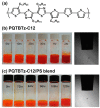Inkjet-Printed Organic Transistors Based on Organic Semiconductor/Insulating Polymer Blends
- PMID: 28773772
- PMCID: PMC5509261
- DOI: 10.3390/ma9080650
Inkjet-Printed Organic Transistors Based on Organic Semiconductor/Insulating Polymer Blends
Abstract
Recent advances in inkjet-printed organic field-effect transistors (OFETs) based on organic semiconductor/insulating polymer blends are reviewed in this article. Organic semiconductor/insulating polymer blends are attractive ink candidates for enhancing the jetting properties, inducing uniform film morphologies, and/or controlling crystallization behaviors of organic semiconductors. Representative studies using soluble acene/insulating polymer blends as an inkjet-printed active layer in OFETs are introduced with special attention paid to the phase separation characteristics of such blended films. In addition, inkjet-printed semiconducting/insulating polymer blends for fabricating high performance printed OFETs are reviewed.
Keywords: inkjet printing; organic field-effect transistor; organic semiconductor; polymer blend; printed electronics; soluble acene.
Conflict of interest statement
The authors declare no conflict of interest.
Figures













Similar articles
-
Microstructural Control of Soluble Acene Crystals for Field-Effect Transistor Gas Sensors.Nanomaterials (Basel). 2022 Jul 26;12(15):2564. doi: 10.3390/nano12152564. Nanomaterials (Basel). 2022. PMID: 35893530 Free PMC article. Review.
-
Ambipolar Small-Molecule:Polymer Blend Semiconductors for Solution-Processable Organic Field-Effect Transistors.ACS Appl Mater Interfaces. 2017 Jan 25;9(3):2686-2692. doi: 10.1021/acsami.6b12328. Epub 2017 Jan 13. ACS Appl Mater Interfaces. 2017. PMID: 28032755
-
All-printed flexible organic transistors enabled by surface tension-guided blade coating.Adv Mater. 2014 Aug 27;26(32):5722-7. doi: 10.1002/adma.201401520. Epub 2014 Jun 18. Adv Mater. 2014. PMID: 24941920
-
Centro-Apical Self-Organization of Organic Semiconductors in a Line-Printed Organic Semiconductor: Polymer Blend for One-Step Printing Fabrication of Organic Field-Effect Transistors.Sci Rep. 2015 Sep 11;5:14010. doi: 10.1038/srep14010. Sci Rep. 2015. PMID: 26359068 Free PMC article.
-
Printed Electronics as Prepared by Inkjet Printing.Materials (Basel). 2020 Feb 4;13(3):704. doi: 10.3390/ma13030704. Materials (Basel). 2020. PMID: 32033206 Free PMC article. Review.
Cited by
-
Microstructural Control of Soluble Acene Crystals for Field-Effect Transistor Gas Sensors.Nanomaterials (Basel). 2022 Jul 26;12(15):2564. doi: 10.3390/nano12152564. Nanomaterials (Basel). 2022. PMID: 35893530 Free PMC article. Review.
-
Development and Characterizations of Novel Aqueous-Based Ceramic Inks for Inkjet Printing.Materials (Basel). 2022 Dec 21;16(1):21. doi: 10.3390/ma16010021. Materials (Basel). 2022. PMID: 36614362 Free PMC article.
-
The potential of paper-based diagnostics to meet the ASSURED criteria.RSC Adv. 2018 Oct 3;8(59):34012-34034. doi: 10.1039/c8ra06132g. eCollection 2018 Sep 28. RSC Adv. 2018. PMID: 35548839 Free PMC article. Review.
-
Photo-Induced Doping in a Graphene Field-Effect Transistor with Inkjet-Printed Organic Semiconducting Molecules.Nanomaterials (Basel). 2019 Dec 10;9(12):1753. doi: 10.3390/nano9121753. Nanomaterials (Basel). 2019. PMID: 31835474 Free PMC article.
-
Review of the Common Deposition Methods of Thin-Film Pentacene, Its Derivatives, and Their Performance.Polymers (Basel). 2022 Mar 10;14(6):1112. doi: 10.3390/polym14061112. Polymers (Basel). 2022. PMID: 35335442 Free PMC article. Review.
References
-
- Sirringhaus H. Reliability of organic field-effect transistors. Adv. Mater. 2009;21:3859–3873. doi: 10.1002/adma.200901136. - DOI
Publication types
LinkOut - more resources
Full Text Sources
Other Literature Sources

